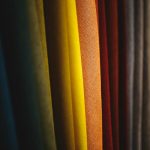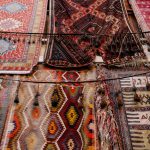When you consider taffeta and silk for your next outfit, it's essential to weigh their unique characteristics. Taffeta's structured form and durability might appeal to you if you value a polished look that lasts, while silk's soft, breathable texture could entice you if comfort and elegance are your priorities. Each fabric has its own maintenance requirements, and your lifestyle will play a crucial role in the decision. So, what factors should you really prioritize when making this choice?
Table of Contents
Characteristics of Taffeta
Taffeta is a crisp, smooth fabric that boasts a slight sheen and offers a lightweight yet structured feel, making it a popular choice for formal wear. It's often used in evening gowns, bridal dresses, and elegant party attire because it holds shape beautifully, giving garments a defined silhouette. You'll appreciate how taffeta drapes gracefully, enhancing your overall appearance without compromising comfort.
One standout characteristic of taffeta is its versatility. Available in various colors and patterns, it allows you to express your style while maintaining an air of sophistication. The fabric's texture is another plus; it feels luxurious against your skin, making it perfect for special occasions.
Taffeta also resists wrinkles better than many other fabrics, meaning you can enjoy your event without worrying about creases. However, keep in mind that it can be less breathable than other materials, so consider the climate when choosing taffeta for your outfit.
Characteristics of Silk
Silk is a luxuriously soft fabric known for its natural sheen and smooth texture, making it a favorite for both casual and formal attire. When you touch silk, you'll immediately notice its unparalleled softness, which drapes beautifully against the skin. This fabric is produced by silkworms, and its unique properties stem from the protein fibers that make it up.
One of silk's standout characteristics is its breathability. It regulates temperature well, keeping you cool in warm weather while providing warmth in cooler conditions. This makes silk an excellent choice for year-round wear. You'll also appreciate its lightweight nature, which adds to its comfort and versatility.
Silk has an elegant luster, offering a radiant finish that catches the light. This quality enhances the visual appeal of garments, making them look more luxurious. Additionally, silk resists wrinkles better than many other fabrics, allowing you to maintain a polished appearance throughout the day.
However, be mindful that silk can be delicate. It requires gentle care to preserve its beauty and longevity. Understanding these characteristics helps you appreciate why silk remains a timeless and cherished fabric choice.
Advantages of Taffeta
This crisp, lightweight fabric offers a unique structure that gives garments a beautiful shape and volume, making it ideal for formal wear and special occasions. Taffeta isn't just about aesthetics; it has several advantages that make it a popular choice for various designs.
- Durability: Taffeta is known for its resilience. It can withstand wear and tear better than many other fabrics, making it a practical choice for garments that need to last.
- Crisp Texture: Its stiff texture helps maintain the silhouette of your outfit, ensuring you look polished and put together throughout the event.
- Easy to Dye: Taffeta takes dye exceptionally well, resulting in vibrant colors that stay true over time. This makes it perfect for those who want to make a statement with bold hues.
- Wrinkle Resistance: Unlike many other fabrics, taffeta resists wrinkles, so you can enjoy your special occasion without worrying about looking disheveled.
Choosing taffeta means you're opting for a fabric that combines beauty with practicality, ensuring you look your best while feeling comfortable and confident.
Advantages of Silk
When considering luxurious fabrics, silk stands out for its unparalleled softness and natural sheen, offering a different set of advantages that elevate any garment.
One of the most notable benefits is its breathability. Silk allows air to circulate, making it comfortable to wear in various climates, whether you're dressing up for a summer event or layering for cooler temperatures.
Additionally, silk has a natural temperature-regulating property. It keeps you warm in winter and cool in summer, making it a versatile choice for any season. You'll also appreciate its hypoallergenic qualities; silk resists dust mites and mold, making it suitable for sensitive skin.
Another advantage is its vibrant color retention. Silk takes dye exceptionally well, resulting in rich, deep hues that won't fade easily. This means your silk garments will maintain their beauty over time, allowing you to enjoy the luxury of silk for years to come.
Comparing Durability and Care
Durability and care differ significantly between taffeta and silk, influencing your choice based on lifestyle and fabric maintenance preferences.
Taffeta is known for its sturdiness; it can withstand wear and tear better than silk. You'll find that taffeta resists wrinkles and stains, making it easier to maintain, especially if you lead a busy life.
On the other hand, silk requires more tender loving care. It's delicate, so you'll need to handle it with extra caution to prevent snags or tears. Silk's luxurious feel comes at a price; it may need dry cleaning or gentle hand washing, which can be inconvenient.
Here's a quick comparison:
- Taffeta: Durable, wrinkle-resistant, and easy to clean — great for everyday use.
- Silk: Luxurious and soft but delicate; requires special care.
- Maintenance: Taffeta often tolerates machine washing, while silk prefers hand washing or dry cleaning.
- Lifespan: Taffeta generally lasts longer in high-use situations, while silk may show signs of wear sooner.
Choose wisely based on how you plan to use the fabric!
Frequently Asked Questions
Can Taffeta Be Used for Evening Gowns?
Yes, you can definitely use taffeta for evening gowns! Its crisp texture and elegant sheen create a stunning silhouette. Just make sure to choose the right design to highlight its unique qualities for your special occasion.
Is Silk Better for Summer or Winter Wear?
Silk's breathable nature makes it perfect for summer, keeping you cool. In winter, its insulating properties help retain warmth. So, it's versatile; you can enjoy silk year-round, depending on how you layer it.
What Are the Environmental Impacts of Taffeta Production?
Taffeta production often involves synthetic fibers, which can harm the environment. You'll find that its manufacturing process contributes to pollution and resource depletion, raising concerns about sustainability and the overall ecological footprint of taffeta fabrics.
How Do Taffeta and Silk Fare in Terms of Cost?
When considering cost, taffeta tends to be more affordable than silk. You'll find taffeta's price usually fits budgets better, while silk, being luxurious, often comes with a higher price tag reflecting its quality.
Are There Hypoallergenic Options for Silk Fabrics?
Yes, there are hypoallergenic options for silk fabrics. You can find silk that's been treated to reduce allergens, making it suitable for sensitive skin. Always check the labels to ensure you're choosing the right product.
- The Use of Nonwovens in Construction and Civil Engineering - July 11, 2025
- The Use of Nonwovens in Construction and Civil Engineering - July 11, 2025
- The Use of Nonwovens in Construction and Civil Engineering - July 11, 2025







